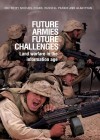Future Armies, Future Challenges: Land Warfare in the Information Age
Written by: Michael Evans, Russell Parkin and Alan Ryan (eds),
Allen & Unwin, Sydney, 2004, paperback,
ISBN: 9781865086262, 370pp.
Reviewed by: Professor Jeffrey Grey, University of New South Wales at the Australian Defence Force Academy.
There is an art to editing conference proceedings, which too often when published are less than the sum of their parts. They often date quickly, and it seems strange that, in the era of the Internet, commercial publishers continue to bother with them. This volume is a refutation of that observation, not least because of the care and skill of the editors, who have ensured that the chapters were current as could be to the time of publication, and who clearly have guided the contributors to that end. The volume contains the proceedings of the 2001 Chief of Army Land Warfare Conference, and could not be more timely. It draws on writers from Australia, Britain, France and the United States, and divides neatly into three, connected sections. These deal with the changing nature of conflict, likely future challenges and recent operational lessons.
There is much here to interest readers of the Australian Army Journal, the chapters by Ralph Peters on the West’s future foes and Roger Spiller on operations in urban areas being especially interesting. Many will probably turn most readily to the chapters that address specifically Australian concerns, and here again there is much to consider. The contributions by Hugh Smith, Alan Ryan and Michael Evans stand out from a strong field.
The first looks at the Issues and problems currently facing the Australian Defence Force (ADF), and notes the very different cultural environment in which it must operate today compared with that which faced earlier generations of Australians. Put simply, Australia is a different place than it was forty years ago, but in many respects the ADF continues to reflect that earlier era of Australia and notes the need to reinforce notions of professionalism, not least through a greater emphasis on higher education for the officer corps, and by implication the need for the ADF to take professional military education as seriously as it takes training. At present this is not the case. The chapter also includes an excellent analysis of the former Ready Reserve (RRes) scheme, abolished in 1996 with too little thought and understanding of its potential in an era of demographic and economic change, and of consecutive, multiple and simultaneous ADF deployments.
Alan Ryan’s chapter on coalition operations draws on recent ADF experience in Cambodia and East Timor, and is likewise concerned with cultural issues and their implications for the success or otherwise of operating in a multinational military environment. These challenges are much more acute for armies than for air or naval forces because of the dominance of the human factor over the platform in the land environment. In the conclusion to the book, which he also wrote, Ryan notes succinctly on this theme that ‘high explosive, however smartly delivered, is a poor tool for resolving those cases of conflict that reside in the human heart’. The continuing requirement for sufficient numbers of highly trained and educated, and properly equipped, ground forces within the ADF is a point that cannot be made often enough in the face of a strategic argument that has long since passed into the realm of theology.
A short summary will not do justice to Michael Evans’s chapter on the changes in the security environment that have taken place since the early 1990s, resulting in what he terms ‘a globalised yet deeply fragmented world’. For my money Evans is the most interesting, and certainly the most erudite writer on defence matters currently publishing in this country. His prose has a force and an elegance largely lacking in the political scientists and defence commentators elsewhere. Evans’s writings are generally a model for Hugh Smith’s broader point about the need to encourage greater intellectual rigour in defence debates in Australia, both those in public and, even more so, those conducted within Defence itself.
The book is a valuable and timely contribution to the public debate of defence issues. It is essential reading for any policy maker seeking to contribute to the formulation of Australian defence policy and strategy. Future Armies, Future Challenges is also essential reading for anyone genuinely interested in the intellectual and professional foundations for configuring and sustaining the Australian Army.


